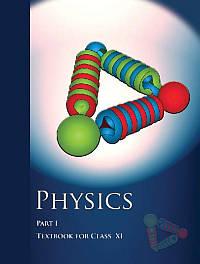NEW! The Gist (FREE) | E-BOOKS |
(Download) NCERT Book For Class XI : Physics (Part-1)

(Download) NCERT Book For Class XI : Physics (Part-1)
Table of Contents
- C H A P T E R-1
PHYSICAL WORLD
1.1 What is physics ?
1.2 Scope and excitement of physics
1.3 Physics, technology and society
1.4 Fundamental forces in nature
1.5 Nature of physical laws - C H A P T E R-2
UNITS AND MEASUREMENTS
2.1 Introduction
2.2 The international system of units
2.3 Measurement of length
2.4 Measurement of mass
2.5 Measurement of time
2.6 Accuracy, precision of instruments and errors in measurement
2.7 Significant figures
2.8 Dimensions of physical quantities
2.9 Dimensional formulae and dimensional equations
2.10 Dimensional analysis and its applications - C H A P T E R-3
MOTION IN A STRAIGHT LINE
3.1 Introduction
3.2 Position, path length and displacement
3.3 Average velocity and average speed
3.4 Instantaneous velocity and speed
3.5 Acceleration
3.6 Kinematic equations for uniformly accelerated motion
3.7 Relative velocity - C H A P T E R-4
MOTION IN A PLANE
4.1 Introduction
4.2 Scalars and vectors
4.3 Multiplication of vectors by real numbers
4.4 Addition and subtraction of vectors – graphical method
4.5 Resolution of vectors
4.6 Vector addition – analytical method
4.7 Motion in a plane
4.8 Motion in a plane with constant acceleration
4.9 Relative velocity in two dimensions
4.10 Projectile motion
4.11 Uniform circular motion - C H A P T E R-5
LAWS OF MOTION
5.1 Introduction
5.2 Aristotle’s fallacy
5.3 The law of inertia
5.4 Newton’s first law of motion
5.5 Newton’s second law of motion
5.6 Newton’s third law of motion
5.7 Conservation of momentum
5.8 Equilibrium of a particle
5.9 Common forces in mechanics
5.10 Circular motion
5.11 Solving problems in mechanics - C H A P T E R-6
WORK, ENERGY AND POWER
6.1 Introduction
6.2 Notions of work and kinetic energy : The work-energy theorem
6.3 Work
6.4 Kinetic energy
6.5 Work done by a variable force
6.6 The work-energy theorem for a variable force
6.7 The concept of potential energy
6.8 The conservation of mechanical energy
6.9 The potential energy of a spring
6.10 Various forms of energy : the law of conservation of energy
6.11 Power
6.12 Collisions - C H A P T E R-7
SYSTEM OF PARTICLES AND ROTATIONAL MOTION
7.1 Introduction
7.2 Centre of mass
7.3 Motion of centre of mass
7.4 Linear momentum of a system of particles
7.5 Vector product of two vectors
7.6 Angular velocity and its relation with linear velocity
7.7 Torque and angular momentum
7.8 Equilibrium of a rigid body
7.9 Moment of inertia
7.10 Theorems of perpendicular and parallel axes
7.11 Kinematics of rotational motion about a fixed axis
7.12 Dynamics of rotational motion about a fixed axis
7.13 Angular momentum in case of rotations about a fixed axis
7.14 Rolling motion - C H A P T E R-8
GRAVITATION
8.1 Introduction
8.2 Kepler’s laws
8.3 Universal law of gravitation
8.4 The gravitational constant
8.5 Acceleration due to gravity of the earth
8.6 Acceleration due to gravity below and above the surface of earth
8.7 Gravitational potential energy
8.8 Escape speed
8.9 Earth satellite
8.10 Energy of an orbiting satellite
8.11 Geostationary and polar satellites
8.12 Weightlessness
Download Free NCERT PDF
Printed Study Material for IAS Exam (UPSC Pre Cum Mains Combo)
Get Gist of NCERT Books Study Kit for UPSC Exams
Go Back To NCERT Books Main Page
Courtesy : NCERT



